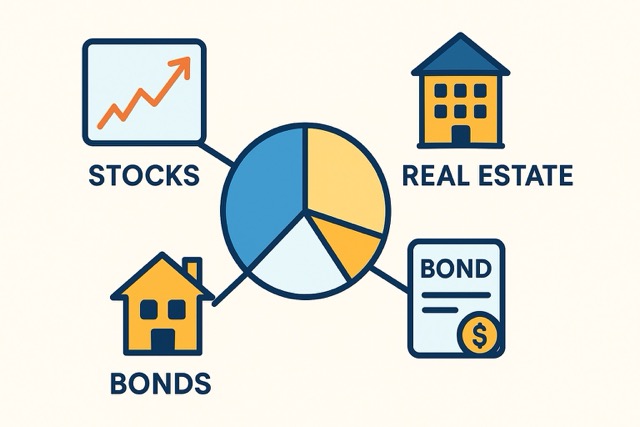When you’re aiming to protect and grow your wealth over the long term, diversification should be one of your most reliable tools. A well-diversified portfolio doesn’t just reduce risk—it positions you to absorb market swings and recover faster when things get volatile. In this article, you’ll learn how to structure your investments across multiple asset classes, sectors, and geographies, using real-world principles that help you build a portfolio that can take a punch and keep moving forward.
Why Diversification Still Works
Diversification works because not all assets react the same way to market changes. When one investment dips, another might hold steady—or even rise. By spreading your capital across a variety of holdings, you avoid putting your financial future in the hands of a single asset class. This isn’t about eliminating risk, but about controlling it. If you’re holding too much in one asset type, you’re exposed to its specific risks. But when your portfolio contains a blend of equities, fixed income, real estate, and cash, you’re better prepared to weather downturns and still capture upside.
Volatility isn’t just a feature of investing—it’s the cost of entry. Diversification gives you a practical way to manage it without trying to time the market or make big bets that could backfire. Think of it as wearing a seatbelt. It doesn’t prevent the crash, but it reduces the damage.
Building Across Asset Classes
Your first step is to allocate across major asset classes. Equities, bonds, real estate, commodities, and cash equivalents each serve a different purpose. Stocks provide growth, but they come with higher volatility. Bonds give you steady income and help offset stock fluctuations. Real estate adds another layer of income potential and often behaves differently from public markets.
Don’t overlook commodities like gold, which can help balance inflation risk, or cash, which gives you flexibility when markets get choppy. A blend of these assets—tailored to your risk tolerance and time horizon—can help smooth your returns. If you’re in your 30s, you may lean heavier into equities. If you’re nearing retirement, you’ll likely want more fixed income and capital preservation tools.
Go Beyond Borders
Geographic diversification is just as important as asset diversification. If you’re invested only in your home country, you’re vulnerable to political shifts, economic slumps, and currency fluctuations tied to one economy. By adding exposure to international markets—both developed and emerging—you reduce that concentration risk.
For instance, the U.S. stock market doesn’t always outperform. In certain years, European or Asian equities take the lead. Emerging markets can offer high growth potential, while developed international stocks offer stability and dividend income. ETFs that track international indices can be a simple way to tap into these markets without the complexity of buying foreign securities directly.
Sector-Level Protection
Different sectors react differently to macroeconomic events. Tech may soar during periods of innovation, while consumer staples remain steady during downturns. By spreading your equity investments across multiple sectors—healthcare, energy, financials, consumer goods, and more—you avoid the trap of overexposure to one trend.
If you’re overconcentrated in technology and it takes a hit, your whole portfolio suffers. But if you’re also invested in utilities and industrials, those areas may help stabilize your returns. You don’t need to be in every sector—but you do need enough variety to absorb shocks without panicking or selling at the wrong time.
Using the Right Investment Vehicles
Diversification isn’t just about what you invest in—it’s also about how. Mutual funds, ETFs, and index funds give you instant exposure to hundreds or even thousands of securities in one vehicle. That helps you diversify without needing to research and buy individual assets one by one.
Index funds are especially cost-effective. They track entire markets—like the S&P 500 or MSCI World Index—with minimal fees. ETFs offer similar exposure but trade like stocks, giving you flexibility. Mutual funds often come with active management and higher fees, but they may make sense if you’re looking for targeted strategies or want help with rebalancing.
You can also use REITs for real estate exposure, commodity funds for metals and agriculture, and even target-date funds if you want a hands-off approach that automatically adjusts your mix over time.
Rebalancing: The Forgotten Discipline
Over time, some parts of your portfolio will grow faster than others. If left unchecked, your allocation will drift, and you may end up with more risk than you intended. That’s where rebalancing comes in. This process involves reviewing your current allocations and making adjustments to bring them back in line with your original strategy.
Rebalancing doesn’t need to happen every month, but checking once or twice a year keeps things on track. If your equities have outperformed, selling a portion and redistributing to bonds or cash helps lock in gains and reduce future volatility. It’s not just maintenance—it’s discipline that protects you from letting emotion or momentum override your plan.
Staying Agile Without Overreacting
Diversification doesn’t mean freezing your portfolio and ignoring market trends. You should still adapt when needed—just not react emotionally. If inflation is rising, you might tilt toward value stocks, commodities, or Treasury Inflation-Protected Securities (TIPS). If interest rates are climbing, shorter-duration bonds may serve you better than long-term ones.
Being flexible doesn’t mean chasing fads. It means using data, reviewing your goals, and being honest about your risk appetite. The best portfolios are built for durability, not just speed. You can be strategic without being speculative. Let diversification be your default, not an afterthought.
Top Diversification Tactics to Protect Your Wealth
- Use multiple asset classes
- Spread exposure across sectors
- Invest globally
- Use ETFs, index funds, and REITs
- Rebalance periodically
- Adjust smartly with changing conditions
In Conclusion
Protecting your wealth through diversification isn’t about following trends—it’s about making sure your portfolio is ready for whatever comes next. Markets rise and fall. Sectors rotate. Economies shift. But a diversified portfolio gives you staying power. By spreading risk, staying disciplined, and using simple tools effectively, you put yourself in a position to preserve capital and capture opportunities over the long haul.
Explore more posts and insights on this WordPress blog: Discover a variety of articles and perspectives.

Thomas J. Powell is the Senior Advisor at Brehon Strategies, a seasoned entrepreneur and a private equity expert. With a career in banking and finance that began in 1988 in Silicon Valley, he boasts over three and a half decades of robust experience in the industry. Powell holds dual citizenship in the European Union and the United States, allowing him to navigate international business environments with ease. A Doctor of Law and Policy student at Northeastern University, he focuses on middle-income workforce housing shortages in rural resort communities. He blends his professional acumen with a strong commitment to community service, having been associated with the Boys and Girls Clubs of America for over 45 years. Follow Thomas J Powell on LinkedIn, Twitter,Crunchbase.

